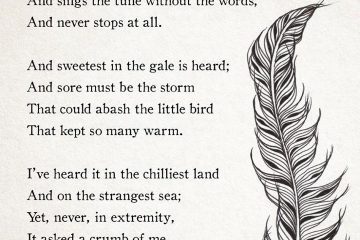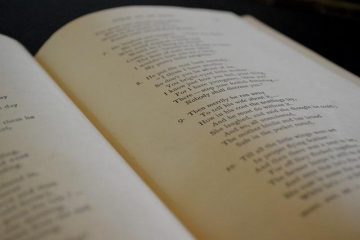Table of Contents
- Exploring the Rhythmic Nature of Poetry Patterns
- Understanding Common Poetic Forms and Structures
- Crafting Your Own Verses: Tips for Pattern Innovation
- The Role of Meter and Rhyme in Poetic Expression
- Analyzing Famous Poems: How Patterns Enhance Meaning
- Q&A
- Key Takeaways


Exploring the Rhythmic Nature of Poetry Patterns
At the heart of poetry lies a captivating interplay of sounds and rhythms that create emotional resonance. Patterns in poetry can take many forms, ranging from the structured to the free-flowing, allowing poets to express complex ideas and feelings. By recognizing these rhythmic elements, readers can appreciate not just the words on the page but also the underlying music of the piece. Common characteristics to consider include:
- Meter: Regular patterns of stressed and unstressed syllables that form the heartbeat of the poem.
- Rhyme: The repetition of similar sounds at the end of lines, which can create harmony and emphasize themes.
- Line Length: Variation in line lengths can manipulate pacing and contribute to the overall mood.
One way to illustrate these patterns is through the use of traditional forms, such as sonnets or limericks. Each of these forms adheres to specific rhythms and rhyme schemes, providing a framework that enhances their thematic content. For example, a sonnet typically follows a pattern of fourteen lines with a specific rhyme scheme, while a limerick carries a distinct rhythm that often leads to an unexpected twist. Below is a simplified comparison of these poetic forms:
| Poetic Form | Structure | Rhyme Scheme |
|---|---|---|
| Sonnets | 14 lines, typically iambic pentameter | ABABCDCDEFEFGG |
| Limericks | 5 lines, anapestic meter | AABBA |


Understanding Common Poetic Forms and Structures
Diving into the world of poetry reveals a rich tapestry of forms that each carry their own rhythmic pulse and emotional weight. Among these, the sonnet stands out as a timeless classic, typically structured in 14 lines with a strict rhyme scheme. This form often explores themes of love, beauty, and mortality, providing poets a canvas for intense emotional expression. Conversely, the haiku effortlessly captures fleeting moments of nature in a mere three lines, adhering to a 5-7-5 syllable pattern that emphasizes brevity and depth. This juxtaposition of lyrical complexity and succinctness illustrates the diverse range of poetic expression.
The table below outlines distinct poetic forms along with their key features, showcasing how each form encapsulates unique themes and structures:
| Poetic Form | Structure | Themes |
|---|---|---|
| Sestina | 39 lines, 6 stanzas of 6 lines + 1 tercet | Memory, Time, Emotions |
| Ballad | Variable, often quatrains | Stories, Romance, Tragedy |
| Elegy | Variable, typically reflective | Loss, Mourning, Reflection |
In addition to these, poets frequently experiment with forms like villanelles—known for their elaborate rhyme scheme and refrains, perfect for exploring obsessive emotions—and odes, which tend to celebrate subjects with grandeur and depth. Each structure not only defines the poem’s aesthetic but also influences the poem’s emotional journey, guiding both the poet and the reader through nuanced thoughts and experiences. By understanding these forms, poets can harness their unique power to elevate their message and connection with their audience.


Crafting Your Own Verses: Tips for Pattern Innovation
When it comes to poetry, innovation often springs from breaking free of traditional constraints. Consider exploring varying meter and rhyme schemes to create your own unique patterns. Here are a few strategies to advance your creative process:
- Experiment with Free Verse: Let go of rigid structures and immerse yourself in the flow of language. Free verse encourages organic phrasing and allows for emotional expression without the confines of meter.
- Mix and Match Forms: Take elements from different poetic styles. For instance, blending the stanzaic structure of a sonnet with the rhythmic essence of a haiku can yield delightful surprises.
- Utilize Visual Layout: Consider how the arrangement of words on the page can reflect the poem’s theme. Visual patterns in your verses can engage readers on a different level.
Incorporating sound devices such as alliteration and assonance can add another layer of depth to your work. These techniques help evoke imagery and emotion beyond mere content. By playing with sound, you can mold how your poetry resonates when read aloud. Here are some techniques to consider:
- Alliteration: The repetition of initial consonant sounds can create a musical quality. For example, “whispering winds” elevates the imagery of peace.
- Assonance: Repeating vowel sounds in close proximity can enhance the flow, as seen in phrases like “through the blue.”
- Onomatopoeia: Using words that imitate the sounds they describe brings your poem to life. Think of “buzz” or “sizzle” for vivacious imagery.
To visualize how you might combine these techniques, consider structuring your innovation process within a simple yet effective framework:
| Technique | Description | Example |
|---|---|---|
| Meter Variation | Mixing iambic and trochaic patterns. | Creating unexpected rhythms. |
| Rhyme Play | Using slant rhymes or internal rhymes. | “Time” and “climb” can reveal deeper connections. |
| Visual Poetry | Shaping text to create visual images. | Words aligned to form a heart. |
These practices can spark your creativity as you endeavor to craft poetry that feels distinct yet impactful. Embrace the challenge of exploring new avenues; your innovation will undoubtedly generate fresh expressions in the world of verse.
The Role of Meter and Rhyme in Poetic Expression
In the vast landscape of poetry, meter serves as the framework that supports the intricate design of each poem. It establishes a rhythmic foundation, providing a pulse that guides the reader through the lines. Various metrical patterns, such as iambic pentameter or trochaic tetrameter, create distinct musical qualities that can evoke specific emotions or set a particular tone. Readers often find themselves swayed by the rhythm, allowing them to feel a deeper connection to the themes being explored.
Rhyme, on the other hand, adds an additional layer of artistry and adherence to structure. This technique not only enhances the melody of a poem but also reinforces meaning through sound. Rhyme schemes, from the traditional ABAB to more complex variations, shape how readers interpret the lines. By creating sonic echoes, poets can emphasize key ideas and foster a sense of cohesion within their work. The deliberate choice of rhyme can thus transform ordinary language into a rich tapestry of sound and meaning.
To illustrate the impact of meter and rhyme, consider the following table that highlights various forms and their characteristics:
| Form | Metrical Pattern | Typical Rhyme Scheme |
|---|---|---|
| Iambic Pentameter | 5 iambs per line (unstressed-stressed) | ABAB |
| Trochaic Tetrameter | 4 trochees per line (stressed-unstressed) | AABB |
| Haiku | 5-7-5 syllable structure | N/A |
The interplay between meter and rhyme encapsulates the essence of poetic expression, fostering creativity while adhering to structure. Poets harness these elements not just as tools, but as essential components that breathe life into their verses, inviting readers on a melodic journey through the written word.


Analyzing Famous Poems: How Patterns Enhance Meaning
Patterns in poetry serve as a vital framework that not only enhances the aesthetic appeal but also deepens the thematic essence. When examining various famous works, it becomes evident that poets frequently employ rhythmic structures, repeated imagery, and rhyme schemes to convey intricate emotions and ideas. For instance, in Shakespeare’s sonnets, the use of iambic pentameter provides a melodic quality that draws the reader in, while also establishing a rhythm that mimics the natural flow of conversation. This rhythmic alignment helps in emphasizing critical moments and intensifying the emotional engagement of the audience.
Additionally, patterns can manifest through the careful placement of refrains and symbols throughout a poem. Take for example the iconic work “The Waste Land” by T.S. Eliot, where recurring motifs of drought and rain symbolize the cyclical nature of life and rebirth. Each repetition not only reinforces the poem’s central themes but also invites readers to create personal connections as they navigate layered meanings. By recognizing these patterns, readers can form a more nuanced understanding of the text, unraveling the multifaceted dialogue between form and content.
Moreover, the structural elements of a poem, such as stanzas and line breaks, play a crucial role in shaping the reader’s experience. The organization of ideas in quatrains versus couplets, for instance, can significantly affect pacing and emotional emphasis. Below is an illustrative table highlighting how different structures can alter interpretation:
| Structure Type | Emphasis | Example |
|---|---|---|
| Quatrain | Complex thoughts; shift in tone | “If it were done when ’tis done…” – Macbeth |
| Couplet | Resolution; closure | “The woven fabric of our fate.” |
| Blank Verse | Natural speech; fluidity | “To be or not to be, that is the question.” – Hamlet |
By dissecting these patterns, we can uncover the deliberate choices made by poets to evoke specific reactions and convey complex messages. Understanding the dance between structure and meaning not only enriches our reading experience but also inspires a deeper appreciation for the craft of poetry.
Q&A
Q&A on Poetry Patterns
What are poetry patterns?
Poetry patterns refer to the structured arrangements of words, sounds, and rhythms in a poem. These can include various forms such as meter, rhyme schemes, and line lengths, which create a recognizable structure that guides the reading and interpretation of the poem.Why are poetry patterns important?
Poetry patterns are significant as they enhance the overall musicality and emotional resonance of a poem. They allow poets to create rhythm, evoke feelings, and establish a unique voice. Patterns can also help to unify the poem, making it more memorable and impactful for readers.What are some common types of poetry patterns?
Common types of poetry patterns include:- Rhyme Scheme: The arrangement of rhymes in a poem, often labeled with letters (e.g., ABAB, AABB).
- Meter: The rhythmic structure of a poem, which includes patterns of stressed and unstressed syllables, such as iambic pentameter.
- Stanzaic Form: The grouping of lines into stanzas that can create a visual pattern on the page, such as tercets or quatrains.
- Repetition: The use of repeated words, phrases, or sounds to create emphasis and rhythm.




0 Comments